Mondo is releasing a very special vinyl version of the soundtrack to Star Trek II: The Wrath of Khan, and we have images and details to share.
From Mondo’s press release:
2016 marks the 50th Anniversary of Gene Roddenberry’s inimitable Star Trek franchise and Mondo is honored to kick the year off with an expanded soundtrack release of arguably one of the greatest chapters in Trek history: The Wrath Of Khan.Composed by the late great James Horner, The Wrath Of Khan is an essential motion picture soundtrack. As he would be asked to do for the Alien franchise a few years later, Horner was brought in to replace Jerry Goldsmith, who composed the previous entry Star Trek: The Motion Picture. Horner was able to produce one of the greatest Trek scores in the now 50-year-old franchise, while also catapulting himself from an unknown into one of the greatest American composers of our time.This deluxe re-issue is pressed on 180 Gram 2XLP Mutara Nebula colored Vinyl, features original artwork by Matt Taylor, exclusive liner notes by Devin Faraci, and has been remastered for Vinyl by James Plotkin.
The 2-LP set features 23 tracks spread over 4 sides:
02. Surprise on Ceti Alpha V (0:45)
03. Khan’s Pets (4:19)
04. The Eels of Ceti Alpha V / Kirk in Space Shuttle (3:53)
05. Enterprise Clears Moorings (3:33)
06. Chekov Lies (0:40)
07. Spock (1:12)
08. Kirk Takes Command / He Tasks Me (2:07)
09. Genesis Project (3:16)
10. Surprise Attack (5:07)
11. Kirk’s Explosive Reply (4:01)
12. Inside Regula I (1:35)
13. Brainwashed (1:24)
14. Captain Terrell’s Death (1:58)
15. Buried Alive (0:57)
16. The Genesis Cave (1:09)
17. Battle In The Mutara Nebula (8:07)
18. Enterprise Attacks Reliant (1:29)
19. Genesis Countdown (6:34)
20. Spock (Dies) (1:53)
21. Amazing Grace (1:26)
22. Epilogue / End Title (8:41)
23. Epilogue (Original Version) / End Title (7:29)
The set will cost $35 and will be available for purchase at Mondotees.com on January 13. The extremely cool Mutara Nebula colored vinyl is limited.

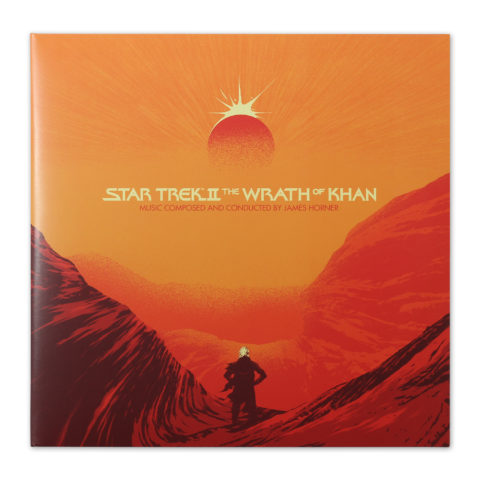
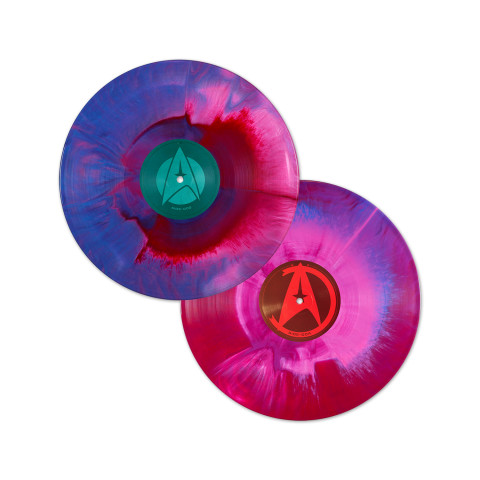
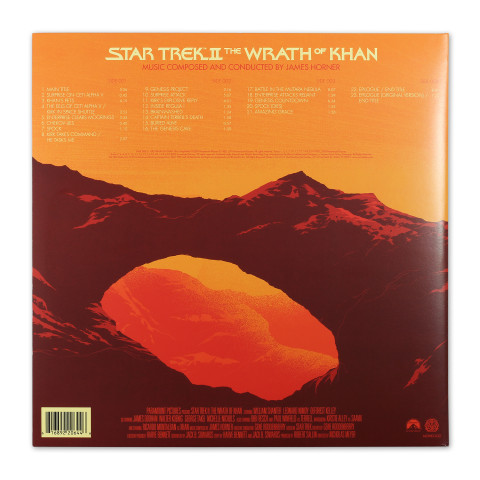
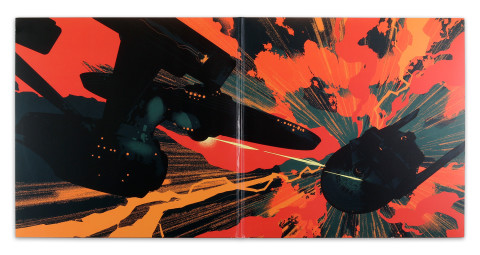
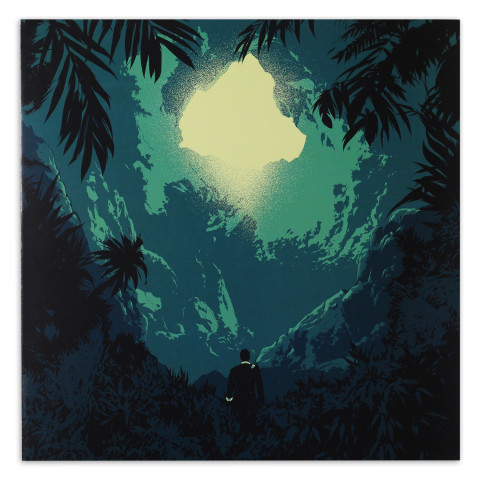
The artwork is spectacular. The record looks to be made of the mutate nebula itself
Well that’s pretty dope.
I kinda don’t understand the point other than as a collectors item.
This was literally one of the first soundtracks ever recorded on digital. So it’s primitive 24/48, mastered through primaries DACs through an analogue console to digital. Remastered for vinyl only means the bass was rolled off so as not to saturate the medium, and likely the highs boosted towards the end of a side where they tend to naturally roll off.
There’s absolutely nothing to be gained by listening to this digital source pressed to vinyl except surface noise. The dynamic range will be attenuated as a result.
Is there new material on here not on the recent multi CD full score release? If not, that’s a better investment than this gimmick.
Curious Cadet – what’s your source that this was recorded to digital at source? That seems very unlikely in 1982, particularly for film soundtracks.
Vinyl seems so hipster now. (Must I grow an Ahab beard? Seems appropos for Khaaaaaan!) Haven’t had access to abturntable since my divorce… twenty-one years ago! Still, this score heavily influenced movie scores for the rest if the decade! Great stuff from the late Mr. Horner.
RenderedToast –
Curious Cadet is correct. I can’t speak to the technical and audio issues he describes, but the score was indeed recorded digitally, and it was clearly indicated on the album cover in 1982:
https://www.dustygroove.com/item/654282
Digital audio recording was happening in Trek even before that – all the dialogue for TMP was recorded digitally.
There are probably other examples from that era, but I can’t think of any at the moment.
Brian Drew – very interesting! I have to wonder what on earth equipment they were using to do that in 1982. Are we sure they were even managing 24/48?! I’m stunned that a major motion picture studio jumped onto untested technology that early.
Vinyl is about the experience. It’s not about the sound. Sitting by a turntable is like sitting next to a fire. Yeah, a standard central heating until heats better, and more efficiently than a fire, but there’s something to be said about watching that wood burn. Same for Vinyl. I know it has less frequency range than what is possible and has the issue of surface noise, but there’s something about dropping a needle into that groove and having that record spin.
El Alto – Ah, vinyl is a passing phase, like BluRay movies. Give me wax cylinders and stereoptican slides any day.
I have a friend who’s all into vinyl. He keeps trying to get me to jump back into that game. Maybe this is the thing that’ll set me down that path.
Vinyl ???
LOL
You know, my HDTV is getting boring. I am going to go retro and start using a ViewMaster again….
I’m waiting for the all new Eyephone version.
Check it out: https://www.youtube.com/watch?v=eJyMEkb_8to
FWIW
You can get a sense of the state of digital flipping through the magazine pages here:
http://www.americanradiohistory.com/Archive-Modern-Recording/80s/Modern-Recording-1980-06.pdf
And while the focus of their TMP article [page 68] is on sound effects recording and mixing, the Goldsmiths were involved with it so there’s some info in there too, as well as a wealth of info on production problems and workarounds.
I get the CD *and* the vinyl. Nothing like holding a huge record cover in your hands. And turntables these days can plug right into your 6.1 Dolby stereo system and you can rip .FLAC files straight from the vinyl. Now that’s hipster.
I’ll take vinyl or CD’s over that compressed crap on iTunes, Google Play, and the streaming services.
What has happened to music is truly sad.
@ Brian Drew
Yes, but for that same reason, I still use CD’s for my music, which has superior sound quality both LP’s and compressed Mp3, etc.
I was having a bit of fine though above — I get it that audiophiles like the high-end LP’s still — it’s a cool hobby.
correction: “a bit of fun”
Hi folks, I produced the FSM CD of the expanded Star Trek II soundtrack release. Our “pre-master” 24/96 files were used by Mondo for the new Star Trek II LP. Since you asked…this score was recorded at the WB scoring stage by Record Plant personnel (Dan Wallin) onto 3M 1″ 32-track digital multitrack and analogue 2″ 24-track backup. This 3M machine was the first multitrack digital recorder and the only surviving working player is at Walt Disney Imagineering, where we took the original masters from Paramount to be transferred. However, the machine actually used an unusual sampling rate of 16 bit/50k…because 50k is not used anywhere anymore (if it ever was), we had to use an analogue cable out of it (sampling at 96, then dithering for 44.1 for the final CD). To be honest, our CD is a combination of digital and analogue sources (Mike Matessino and Neil Bulk would know more) and if you can tell the difference by ear I’ll eat my hat. Personally I am baffled by the recent trend of vinyl reissues…in the 1980s I had to track down the original Atlantic Records LP of Star Trek II (out of print), order it by mail and make a cassette to play on the school bus on my walkman! So I am old enough to hate vinyl from the days when we were beholden to it, but I get the idea of the cover art and having a nice collectible… now that we rip everything to iTunes, whether you buy a CD or LP is sort of a decorating choice. Whatever the case the new release by Mondo is very attractive, and I am happy to have contributed in some way to this classic score being accessible to the people who love it, as I do.
Star Trek II was recorded digitally with the 3M digital system. This is a virtually extinct format (Disney still has a machine) that recorded at 50kHz/16-bit.
Talk about Paramount once again beating the money tree regarding Wrath Of Khan.
What’s next? A streaming version of TWOK done with shadow-puppets?
That and SMELL-O-VISION are the only two iterations left!
I am no audiophile, but I do get the notion of analog originals to vinyl…but the idea of a digital original to vinyl kinda escapes me. You know going in that any of the “vinyl artifacts” are…just artifacts of the conversion…..nothing really to do with the source material. But, hey, whatever floats your boat, I s’pose. I guess as long as Par gets a license fee that’s all that really counts these days.
#19. Lukas Kendall – January 9, 2016
I wouldn’t expect you to foot the bill in terms of cost effectively converting the 3M digital data, but digital is just a bunch of numbers and I would expect Paramount as a matter of archiving would have. 50kHz/16-bit is not a standard in the recording industry today but there were plenty of computer sound cards whose digital inputs were mostly just software that could be reprogrammed to handle it with specialized software written specifically for that 3M stream, again a cost no one would expect your project to foot but I would expect Paramount to realize the wisdom of going to the trouble and expense of hiring programmers to do so.
#23 – Disinvited,
3M Digital machines don’t have a digital output to allow this.
wow
will have to buy record player
@8. El Alto,
Actually a good LP pressing can reproduce higher frequency response than a CD, depending on equipment. That’s not the issue. The issue is dynamic range, which is far more limited on analogue.
@19. Lukas Kendall,
Thanks for stopping in to reconfirm that. Yes they were still doing 24 track backups into the 90s. Hollywood can be quite conservative. Did you re-sample the original at 96K because it was originally sampled at 50k, instead of the standard 48K to presereve all the original material? Or did I understand that you took it out of the analogue outputs? If so, did the DAC to the analogue output reproduce the full 50K range from which to sample?
And I’m assuming the original 32 track recordings weren’t re-mixed, you merely took the final stereo mixes to remaster for CD, right? Does that mean you had to transfer each program track one by one?
@22 Soonerdave,
Digital to vinyl allegedly makes some sense depending on the source sample rates. 24/96k digital source technically reproduces a higher frequency range on vinyl than a CD. So that’s supposedly better. Again it’s the dynamic range that suffers.
I have the reissue CD produced a few years ago, so I really don’t need this vinyl release. But it would be nice to collect. I still have 2 copies of the original LP from years ago. This record was the first record I ever bought myself on purpose (meaning I wanted this, not bought it because it looked nice). I really wonder how the sound would be if they remixed it from the analog tape instead? I’m sure fidelity would be improved, since digital back then was in its infancy and not sonically the best.
Lukas & Neil –
Thanks for providing some clarity on the tech specs. I can’t wait to get this. The packaging alone is worth the purchase!
My sister gave my son an old vinyl record player, which also comes with CD changer player, cassette player and radio. Unfortunately, the record player amplifier is shot, but CDs can still be played.
We still have some vinyl LPs, some of which are about 60 years old and belonged to my father. We keep them as heirlooms, but who knows, with a good amplifier, perhaps they could get played again. We also had a 78 with an opera singer Galli- Curci (1882-1963) singing the aria “Queen of the Night” by Mozart, but I have no idea what happened to it…:( My father often played when I was a child. Record players then came with 33, 45 and 78 player capacity. I don’t know the tech names.
I actually owned a small portable record player, which folded into what looked like a small suitcase, with the three player options. Unfortunately, the speakers weren’t that good, but that’s all I could afford and I could take it anywhere as long as there was a power outlet.
The James Horner TWOK music is lovely. Good to wonderful theme music is a Star Trek trademark.
None of this addresses my concerns in archiving the pristine original data BFFR:
http://tinyurl.com/DangleReview2003
“According to the album’s engineer, Roger Nichols, THE NIGHTFLY was recorded on a 32 track 3M machine at 16-bit/50khz. Nichols did the tape transfers for the DVD-Audio disc from the original 3M machine (which he still has) to 24-bit/48khz Pro Tools using Apogee converters.” — ‘Donald Fagen: The Nightfly (DVD-Audio), Reviewed By: Felix E. Martinez, Reviewed On: 01/03/03
Apparently, those Apogee converters can handle the 50 kHz rate.
This 3M sales guy might have been blowing smoke but he claimed:
https://tinyurl.com/Billboard10-31-811
“The 3M machines that now operate at 50 kHz can be adjusted [to 48 kHz] simply.” — Clark Duffey, 3M digital audio sales manager
#24. Neil S. Bulk – January 10, 2016
I see what you mean:
http://files.computeraudiophile.com/2011/1028/the-3m-manual.pdf
but given how separable its parts are its probably not that difficult to get the signal it feeds its DACs. But I can definitely understand why someone would not want to monkey around with a functioning antique.
Lukas & Neil
Definitely agree with Brian, thank you. I was an audiophile back in the day and nothing beats a bit of clarity.
Brings back memories – I had the original LP soundtrack and remember listening to it in my college dorm room in 1982, with eyes closed just to relive the experience in my head after seeing the movie 6 times at the theater, because I didn’t have/couldn’t afford a VCR to actually watch the movie! lol
@Lukas Kendall
I have decided to purchase this as a collectors item. Love the artwork! Great job!
@ Curious Cadet
Assuming they still have the master for this, then a CD transfer from the 3M master digital recording — being that CD is of course in digital format — is always going to be the highest quality listening solution that best represents the sound of the orchestra as originally recorded to the studio. Whereas, an analog transfer from digital would result in some loss of the original sound elements.
31. Disinvited – January 10, 2016,
This article by Roger Nichols explains why you want to record analog out from these machines.
http://www.soundonsound.com/sos/may06/articles/rogernichols_0506.htm
Boborci! I gave you and Alex K. an advance CDR copy of the complete Star Trek II soundtrack after some Q&A you did I think at the WGA building on Doheny many years ago. Check above the dashboard of your car, it’s probably right where you left it.
We used the original Dan Wallin LCR mixes made in 1982, they were superb, except for one patch we remixed from the 24-track to get rid of an oddity that made it seem like an instrument “jumped” across the stereo field. I’m afraid I can’t answer the subtleties about analog vs. digital on that ancient 3M player. They told me that they had to go analogue out on it because of the 50k issue (all 32 tracks are recorded at once into Pro Tools) and at their hourly rate I was not going to argue.
Lukas,
I remember burning those CDs!
Curious Cadet your comments are spot on.
The recent cd re-release is outstanding.
36. I have it! Wrote my version of Trek 3 lostening to it!
Just not on vinyl;)
This comment thread is exactly why I rarely participate in the Trek community anymore. You people will b!tch about anything. Be grateful for something unique, for once.
#41 – Who is bitching on this thread? I think you have posted on the wrong thread.
@35. Neil S. Bulk,
Thanks for that link. It appears those 3M machines didn’t even have a digital out. So they recorded digital, mixed the analogue signals, and re-recorded to digital. Analogue boards are still pretty common today, so nothing has changed in that regard.
However, it does shed some light on the final mastering process. The LCR mix is one generation removed from the original digital multitracks. So the mastering to vinyl is two generations removed, as is the CD red book master. But essentially what’s on the album is the same thing as what’s on the CD. And more than likely the vinyl represents more of the 50k information than is contained on the GNP CD which was limited to 44.1k, but without the dynamic range.
However, this new vinyl is made from a third generation master, having been transferred to a new digital medium via analogue, before being remastered to analogue. Likewise from the Expanded CD unless it was mastered digitally.
So one day we might get a 2nd generation version which is a direct digital transfer to a digital medium capable of lossless 24/50. Can’t wait!
Huh?
+++++++++++++++++++++++++++++++++++++
41. Christopher – January 10, 2016
This comment thread is exactly why I rarely participate in the Trek community anymore. You people will b!tch about anything. Be grateful for something unique, for once.
@ Curious Cadet
Good explanation — thanks!
David Bowie is dead at 69 after an 18 month battle with cancer. RIP.
I love vinyl. I shall get this.
RIP “Rocketman”
whoops, meant “Major Tom”
must be getting senile.
If movie STII ever gets remastered again, the title font should be changed to the one used in STIII. It must be what most people want because it’s used on the deluxe CD and here on the album.